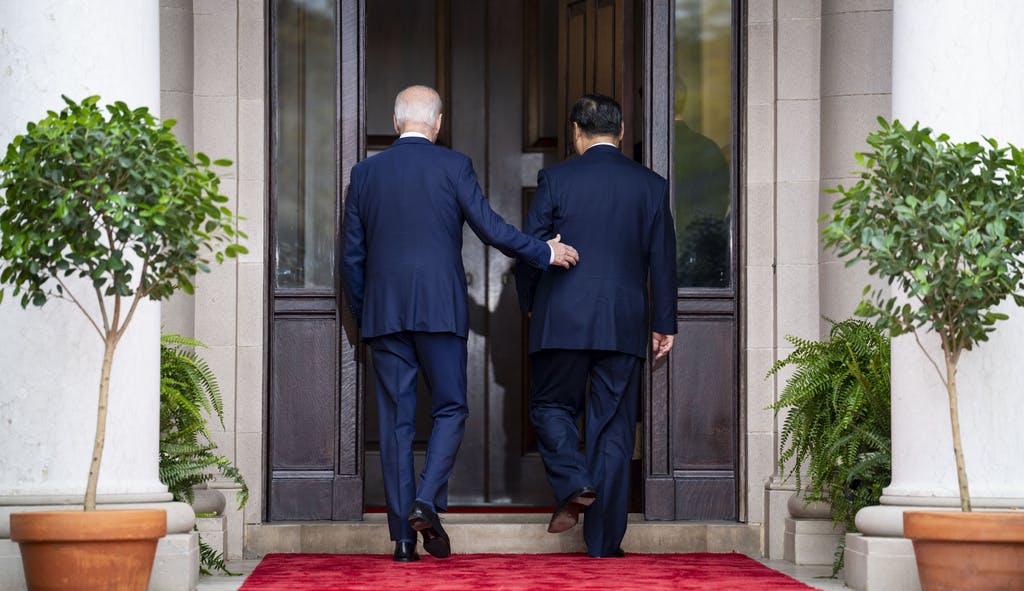Biden, Xi, at Their Parley on the Coast, Go Bumper to Bumper — Over Their Cars
The leaders boast of progress at their so-called summit, but they never get out of low gear.

“It’s a beautiful vehicle,” President Biden said to President Xi as they walked out of the Bay Area mansion where the two heads of state held their first face-to-face meeting in more than a year on Wednesday.
“This is our Hongqi sedan, homemade,” Mr. Xi responded, pointing to his black, custom-built model of the luxury Chinese car, whose name means, ‘red flag.’ “Please open and have a look.” Mr. Biden approached the car and investigated its interior.
“It’s like that Cadillac we have over there,” he said, glancing toward his own presidential vehicle, large enough to function as a rolling Oval Office. “At international meetings, they fly those with me. And you know what they call that car?” Mr. Biden shook Mr. Xi’s hands, their eyes locking and faces illuminating with the flashes of photographers. “They call it,” he said, “the Beast.”
The heads of two economic rivals smiled wide, said thank you, and bid the other goodbye until the next day, when they’d meet again as part of the gathering of the leaders of 21 countries taking place at San Francisco this week, the Asia Pacific Economic Cooperation.
“No superpower summit is complete without its moment of automobile one-upmanship,” historian Niall Ferguson wrote on X in response to a video of the exchange. Indeed, the contest over high-tech cars and other consumer goods also underscored tensions between America and the Soviet Union during the Cold War. As Mr. Biden and Mr. Xi stake a path to diplomacy in what foreign policy pundits warn is a “new Cold War,” the original one offers some cues.
“Let the people choose the kind of house, the kind of soup, the kind of ideas that they want,” Vice President Richard Nixon said to Soviet Premier Nikita Khrushchev in the famed 1959 “Kitchen Debate.” At that exhibition of consumer goods at Moscow, it was not the Cadillac, but the newly-minted, glistening white Ford Thunderbird, that symbolized American superiority to the Communist enemy. Consumer choice, Mr. Nixon urged, was the great achievement of capitalism.
A “systems rivalry” also characterizes the downward spiral in Sino-American relations today, a senior research associate at the Harvard Kennedy School’s Center for Science and International Affairs, Evan Sankey, tells the Sun. “A common thread here is both in the early Cold War and today in US-China relations, there’s a sense that things are getting worse.”
Like the Kitchen Debate, Mr. Biden’s meeting with Mr. Xi occurred during what Mr. Sankey calls “an Indian summer” in the general context of worsening relations. The White House subsequently announced a resumption of military-to-military communications with China, a bilateral agreement to combat illegal drug trafficking, and a shared commitment to mitigating climate change.
“We made progress,” Mr. Biden said in a press conference after the meeting. Both the American and Chinese readouts included a statement of principles and stated a common interest in arms control — a sign that policymakers on both sides have studied the lessons of the Cold War. Mr. Biden emphasized his expectation that “cross-strait differences be resolved by peaceful means,” as “the world has an interest in peace and stability in the Taiwan Strait.”
The meeting was “a very important and successful step towards stabilizing a relationship in which we will simultaneously be the fiercest rivals history has ever seen,” American political scientist and former Assistant Secretary of Defense, Graham Allison, tells the Sun. “That’s baked into the structural fact of a rising China challenging a ruling US,” a phenomenon he has popularized as the Thucydides Trap.
Yet a sharp divide remains between the two nations. Mr. Biden, in his press conference, called Mr. Xi “a dictator,” explaining that “he is a guy who runs a country that is a Communist country that’s based on a form of government totally different than ours.” A spokesman for the Chinese Foreign Ministry criticized that comment as an “irresponsible political maneuver, which China firmly opposes.”
While the points of consensus reached on Wednesday suggest “progress,” Mr. Sankey says, “the time is not right for those ambitions to blossom into some concrete accomplishment in bilateral relations.”
The kind of conflict the US and China are mired in resembles what Mr. Kennedy called a “long twilight struggle.” For him, the path out of that struggle only emerged with the testing moment of the 1962 Cuban Missile Crisis. The threat of mutually assured destruction alerted both the Americans and the Soviets of the urgency to de-escalate tensions, paving the way for more comprehensive bilateral agreements.
“There has not yet been a critical crisis which forces both sides to stare into the abyss of nuclear war,” Mr. Sankey says. “We’re not scared enough, on either side — but especially the US.” He wonders: “Are we going to have to experience such a thing again in order for there to be significant, constructive progress in US-China relations?”
Nixon and Khrushchev’s verbal sparring in 1959 hinted at the deep disagreement between the Cold War superpowers. “You never concede anything,” Nixon said after Khrushchev boasted that his rockets were better. He then mocked, “You’re a lawyer of Capitalism, I’m a lawyer for Communism. Let’s kiss.” Just three years later, those “lawyers” came closer than ever to nuclear conflict.
In great power summits throughout history, “each leader was trying to test the mettle of their counterpart,” Mr. Allison says. For America and China, he warns, “the question is whether leaders can take account of the fact that left to history as usual, to business as usual, to diplomacy as usual, this will likely end in a war.” The battle, for now, is between Mr. Biden’s Cadillac and Mr. Xi’s Hongqi.

